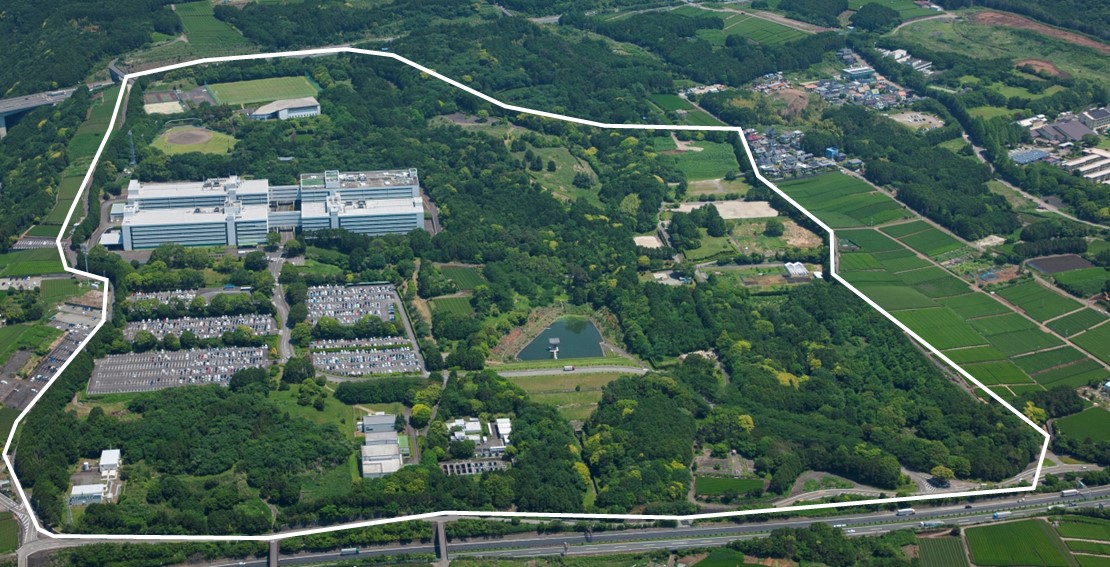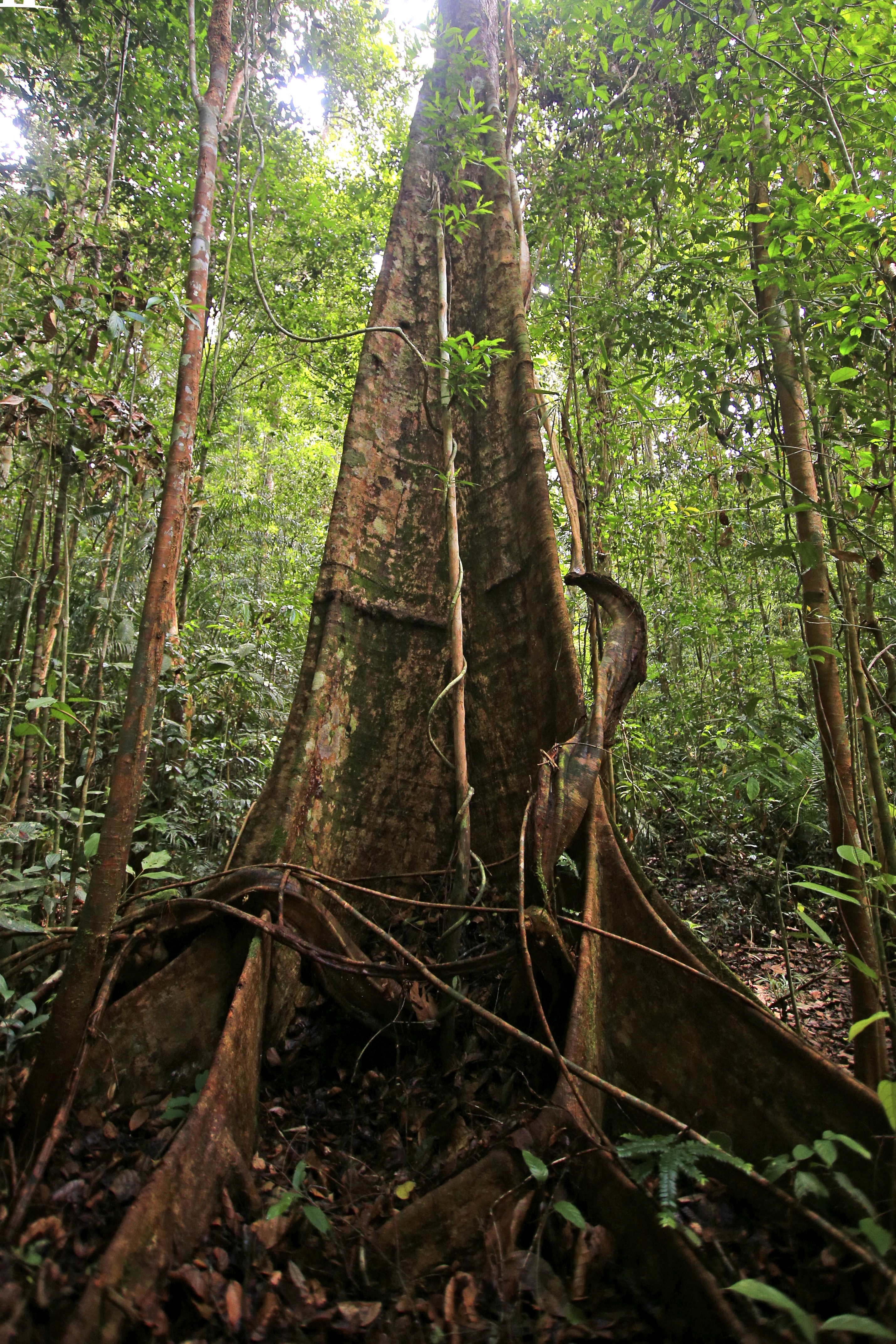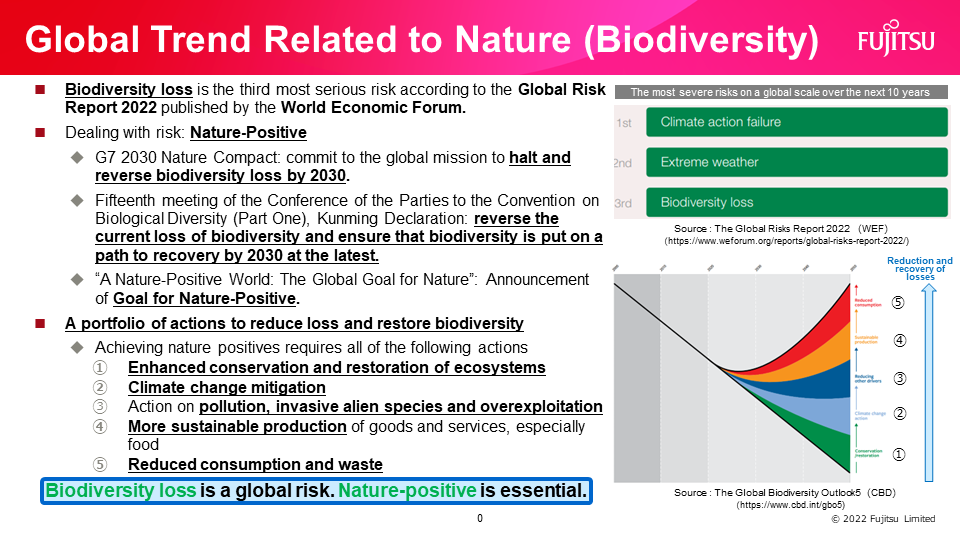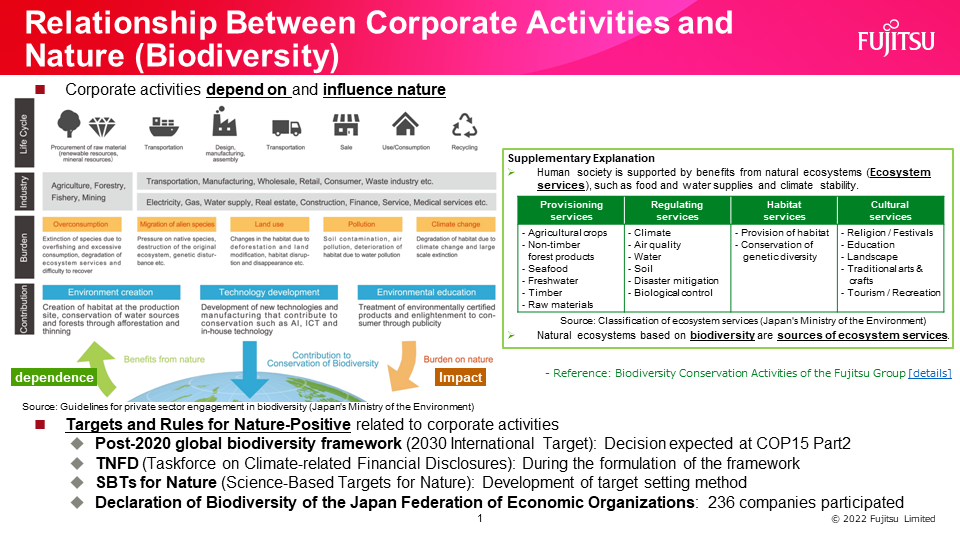Living in Harmony with Nature (Conservation of Biodiversity)
Vision and Short- to Mid-term Targets
Together with climate change, the loss of biodiversity is seen as a serious and urgent problem, and the delivery of nature-positive outcomes is considered essential to its resolution. At the G7 Summit, held in June 2021, we agreed on a G7 2030 Nature Compact, which includes a commitment to “halt and reverse biodiversity loss by 2030”. During part 2 of the 15th Conference of the Parties to the UN Convention on Biological Diversity (CBD-COP15) - held in December 2022 - the Kunming-Montreal Global Biodiversity Framework, which includes international targets for 2030, was adopted. The framework establishes “23 Global Targets for 2030” aimed at the 2030 Mission “To take urgent action to halt and reverse biodiversity loss to put nature on a path to recovery for the benefit of people and planet” (excerpt).
Committed to delivering nature-positive outcomes, in 2022 the Fujitsu Group formulated its vision for 2050, its 2030 Mid-term Target, and its 2025 Short-term Target (Environmental Action Plan Stage XI) in line with international targets (Kunming-Montreal Global Biodiversity Framework). Achieving the vision will contribute to satisfying the Fujitsu Group’s stated purpose to “Make the world more sustainable by building trust in society through innovation.”
Create a world in harmony with nature, where "nature and biodiversity," which are fundamental to a sustainable society, are fully restored through digital technology.
Reduce negative impacts on biodiversity by at least 25% (Base year : FY2020) within the scope of the company's corporate activities, including supply chain, and promote activities to increase positive impacts on it.
Reduce negative impacts on biodiversity by at least 12.5% (Base year : FY2020) within the scope of the company's corporate activities, including supply chain, and promote activities to increase positive impacts on it.
Response to the Taskforce on Nature-related Financial Disclosures (TNFD)
The Fujitsu Group is committed to achieving the abovementioned vision it has established for delivering nature-positive outcomes in line with international targets (Kunming-Montreal Global Biodiversity Framework). The Group endorses the purpose of the Taskforce on Nature-related Financial Disclosures (TNFD), and is a registered TNFD Adopter. In FY2024, the Group implemented the LEAP (Locate, Evaluate, Assess and Prepare) approach (Phase 1), mainly in its direct operations (including in some of its upstream value chain).
Same as the Fujitsu Group’s TCFD-based information disclosure
Priority locations: Plan to confirm details of any negative impacts for three plants outside Japan, starting now
Dependencies and impacts: Possible impact from any emissions of harmful pollutants to water or soil
Risks and opportunities: List multiple risks in terms of raw materials procurement or laws and regulations
Same as the Fujitsu Group’s TCFD-based information disclosure
Set targets for reflecting several elements of all corporate activity in line with international targets
Study individual risks and opportunities after additional analysis and assessment
In FY2025, we will implement the LEAP approach (Phase 2) mainly in our upstream value chain, and fine-tune the disclosure information.

Biodiversity Conservation Activities
The Fujitsu Group is undertaking various biodiversity conservation activities to achieve its vision and targets.
Activity Example 1: Complying with the Environmental Action Plan Target to “Visualize and reduce the impact of corporate activities on ecosystems and on biodiversity”
As part of Stage XI of its Environmental Action Plan, the Fujitsu Group has set a target for conserving nature and biodiversity, and has commenced activities to evaluate and reduce the nature and biodiversity-related dependencies and impacts of the Group’s corporate activities.
Activity Example 2: Contributing to 30by30 (*1) (Ministry of the Environment: Activity to Gain Certification for Nationally Certified Sustainably Managed Natural Sites)
Just under 80% of the approximately 53 ha site occupied by the Fujitsu Numazu Plant is given over to green space to nurture the precious biodiversity of the region. The factory manages the green space with the aim of preserving the natural environment, maintaining the landscape, and providing a place for employees and local residents to learn about the natural environment. In 2022, Numazu Plant’s green space program participated in the screening process of a trial scheme to test a system established by the Ministry of the Environment (MOE) to certify conserved areas identified as Living in Harmony with Nature. It was consequently certified by the MOE as a “Nationally Certified Sustainably Managed Natural Site” in 2023. This activity is ranked as an activity that will increase the positive impact on biodiversity in the Group's short- and mid-term targets.
*1: 30by30: A target which aims to effectively conserve 30% of land and sea areas as healthy ecosystems by 2030 with the goal of halting and reversing biodiversity loss by 2030 (nature-positive outcome)

(Ministry of the Environment: Nationally Certified Sustainably Managed Natural Sites)

- [PDF] Outline of sites participating in the early trial phase of Areas Living in Harmony with Nature (working title) (MOE website) (Japanese text only)
- Fujitsu Numazu Plant is awarded the 2023 Prime Minister’s Commendation for Meritorious Service to the Greening Promotion Campaign (Japanese text only)
Activity Example 3: Supporting Biodiversity Conservation by Providing Funds, Technology, and Talent
The Fujitsu Group supports the activities of organizations that implement biodiversity conservation. These activities are ranked as activities that will increase the positive impact on biodiversity in the Group's short- and mid-term targets.
1. Blakiston’s Fish Owl Call Recognition Project
The Fujitsu Group has provided the Wild Bird Society of Japan with call recognition software, developed for use in habitat surveys of the endangered Blakiston’s fish owl. Implementing measures based on habitat survey results is important for the conservation of the species. Surveys are conducted by analyzing sound data recordings, but the main challenge for the Wild Bird Society was that playing and replaying the recorded sounds to identify the Blakiston’s fish owl was enormously time-consuming. By providing the call recognition software, we helped streamline the surveys to enable the automatic extraction of the owl’s cries, thus greatly reducing the time required for analysis.
2. Supporting the Harapan Rainforest (Forest of Hope)
Since 2018, the Fujitsu Group has continuously supported a project launched by BirdLife International Tokyo for forest conservation activities in the Harapan Rainforest (Forest of Hope) on the Indonesian island of Sumatra. The Hutan Harapan rainforest is a massive forest of around 100,000 hectares (about half the size of Tokyo), located on the southern side of the island of Sumatra. This is the first area in Indonesia set aside as an Ecosystem Restoration Concession (Rights to use forests in a non-logging manner, such as the production of non-timber forest products), and rare animals such as the Sumatran tiger and Sumatran elephant still exist there. In addition to protecting the forest from threats such as forest fires and illegal logging, activities are conducted to restore the original ecosystem of secondary forests that were previously commercially logged.
Forest patrols were being conducted as an urgent response to large-scale forest fires and illegal logging in the Hutan Harapan rainforest. However, because of the time and effort involved in conducting the patrols and aggregating information, those efforts restricted the resources available for the original mission of forest restoration. The Fujitsu Group has suggested digital technology use to support more efficient forest patrol activity. The use of digital technology expanded new communications infrastructure and the construction of forest monitoring dashboards, effectively countering the destruction of forest and contributing to its conservation.
For further details refer to “Contributing to forest conservation through ICT (*2)”.

3. Coastal cleanup activities on Tsushima, An Island Seriously Contaminated by Marine Plastics
To deepen employees’ awareness of the global environmental issue of marine plastic pollution, and link this to action to deal with the problem, Fujitsu Limited held a hands-on eco-tour of Tsushima for Fujitsu Group employees in collaboration with the Japan Environmental Action Network (JEAN). The project involved a beach cleanup, and an ideathon to come up with solutions to the island’s marine plastics problem.
4. Marine monitoring project “Nosoko Umishobu Seagrass Colony (Nationally Certified Sustainably Managed Natural Site), Ishigaki Island” and related educational activities for students of local elementary school
We are participating in a joint project to advance the conservation of an umishobu seagrass (Enhalus acoroides) colony in the Nosoko area of Ishigaki Island. This involves using an underwater drone to monitor the marine environment and assess seagrass growth in the conservation area. We also held classes for students at a local elementary school to teach them about monitoring techniques and the importance of data.
Activity Example 4: Promoting Initiatives in Collaboration with External Organizations (J-GBF, Keidanren, WIPO, JBIB)
The Fujitsu Group collaborates with various external organizations to promote the following initiatives for conserving biodiversity:
- Japan Conference for 2030 Global Biodiversity Framework (J-GBF): Fujitsu Group announced and registered its Nature Positive Declaration.
- Keidanren: We support The Declaration of Biodiversity by Keidanren and participate in the Initiative based on the Declaration of Biodiversity.
- MOE: Fujitsu Group’s case study Blakiston’s Fish Owl Call Recognition Project was selected and published on the Business for GBF Project website launched by MOE as one of the good cases by Japanese companies contributing to the biodiversity conservation through their business activities. Furthermore, it was also featured in the Business for GBF Project’s promotional video.
- World Intellectual Property Organization (WIPO): Participates as a partner in WIPO GREEN, a matchmaking platform for transferring environmental technologies and services. This led to the conclusion of IP licensing agreements with academic institutions for the use of technologies for conserving natural assets and biodiversity.
- Japan Business Initiative for Biodiversity (JBIB): Hosting activities together with enterprises for the purpose of research and practice in biodiversity conservation.
- Nature Positive Declaration: List of participating organizations ((J-GBF Website) Japanese only)
- Initiative based on The Declaration of Biodiversity by Keidanren (Keidanren website)
- Business for GBF Project (MOE website)
- Promotional video for Business for GBF Project (MOE video)
- Conclusion of IP licensing agreements through WIPO GREEN activities
- Japan Business Initiative for Biodiversity (JBIB) (JBIB website)
Activity Example 5: E-learning for Employees
The Fujitsu Group provides environmental education through e-learning programs for all employees to improve their environmental engagement. The programs include content on global trends in biodiversity and the relationship between corporate activities and biodiversity, the intention being to deepen their understanding of how their work relates to biodiversity.


Fujitsu Group Biodiversity Action Principles
In October 2009, the Fujitsu Group established its "Biodiversity Action Principles" to explicitly address biodiversity.


